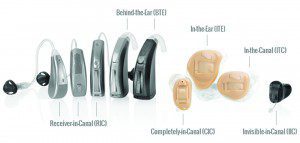By Dr. Noël Crosby, Au.D.
There are hundreds of different hearing aids and hearing aid terminology can be confusing. I am going to define some of the most common hearing aid features and hearing aid styles to help you better understand your options when choosing hearing aids that are correct for you. Sometimes those of us that work with hearing aids can forget just how foreign the terminology can sound to you.
Directional Microphones are more sensitive to sounds approaching from one direction, such as the front, while reducing unwanted sounds from other directions. This feature can make it easier to understand speech when there is background noise.
Adaptive Directional Microphones can follow moving sounds or reduce several different sounds at the same time.
Bluetooth Compatibility allows hands-free use of compatible wireless devices like cell phones. Sometimes additional devices and or accessories may be required.
Direct Audio Input enables the hearing aid to receive input from another device such as a TV or personal entertainment system.
Feedback Suppression reduces feedback (whistling) which is the number one complaint people have about hearing aids. Most hearing aid wearers experience feedback when they put their hand over their ear or use the phone.
Impulse Sound Management provides protection from sudden loud sounds.
Noise Reduction automatically reduces the level of noise to give you a more comfortable listening experience in noisy environments
Programs are different settings or memories for different situations such as quiet places, noisy places, and telephone use. Some hearing aids can have memories that adjust automatically or a combination of both manual and automatic adjustment.
Remote Control is an optional accessory with some hearing aids that allows the wearer to make adjustments to their hearing aids.
Speech Enhancement technology allows hearing aids to detect certain frequencies within each sound of speech and provide extra amplification to those frequencies.
Telecoil amplifies sound from the telephone or loop amplification system without picking up background noise, which helps prevent feedback on the phone and improves the signal to noise ratio in a large public venue.
Toggle/Button control allows the hearing aid wearer to manually change programs for different listening environments.
Bands and Channels are the features that refer to the ability to adjust hearing aid settings to best fit individual hearing loss needs. In most cases, the more bands and channels a hearing aid has, the better it can be programmed to perform for the user.
Wind Noise Manager is the feature within a digital processor that reduces the sound of wind noise on the microphone.

In the Ear (ITE) hearing aids are the largest custom style of hearing aid, filling the entire bowl of the ear or a portion of the bowl of your ear, and can have the most power and features available for in the ear hearing aids.
In the Canal (ITC) is the next smallest size custom hearing aid. It is less visible than the larger hearing aids, but also not able to have as much power or as many features.
Completely in the Canal (CIC) or (IIC) are the smallest custom, in the ear hearing aids, and are quite popular due to their cosmetic appeal and ease of use. There are usually no manual controls on these hearing aids. Telephone usage is often better because they are less likely to whistle. Lack of power is the main reason people cannot use this style of hearing aid, although a small ear canal may also prevent some people from being able to wear this style.
Open Fit (OE) and Behind the Ear (BTE) hearing aids sit behind your ear and are connected to your ear by a tube with an earmold attached. These hearing aids have the most power and features available. An open fit hearing aid is connected to your ear by a very thin tube with an earbud attached to the tube. They are called open ear because they leave the ear canal less blocked than other style of hearing aid.
Receiver in the Ear (RITE) or Receiver in Canal (RIC) hearing aids are a fairly new style which has become available in recent years and are much smaller than a traditional BTE. They are meant primarily for high frequency hearing loss. The hearing aid is connected to the receiver by a very thin tube with a wire. The receiver is positioned in the ear canal with a small ear bud attached to it or an earmold.
You should consult with your hearing health care professional to determine which of these features or styles could benefit you the most. The smaller the hearing aid the smaller the battery that can be used. This can result in shorter battery life. Another thing of importance is that some styles of hearing aids require more manual dexterity. The more challenging the listening environment, the more these features or styles can better assist you with your hearing and understanding. After all, the goal is for you to hear and understand better!
PROFESSIONAL BIO
Dr. Noël Crosby, Au.D., owner and audiologist at Advanced Hearing Solutions in Englewood, FL is a licensed professional whose 26 year career has been devoted to helping people of all ages hear and understand more clearly. Dr. Crosby received her BS and MS degrees from FSU and her Doctorate in Audiology from UF. Her credibility as an authority grew during her tenure as the Director of Audiology at the Silverstein Institute in Sarasota, FL from 1991-1998. Today, in addition to managing a successful audiology practice, Dr. Crosby is involved in creating hearing loss awareness through her jewelry and accessory company AuDBling.com. She has served and is serving on various professional boards and committees and was president of the Florida Academy of Audiology in 2000 and 2010. She has been married to Michael for 23 years and has one daughter.
For more information contact Noël’s office at 941-474-8393 or you can visit her website at www.advancedhearingsolutions.net.







